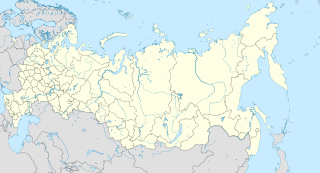This page is based on this
Wikipedia article Text is available under the
CC BY-SA 4.0 license; additional terms may apply.
Images, videos and audio are available under their respective licenses.
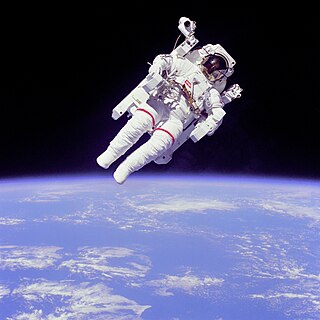
An astronaut or cosmonaut is a person trained by a human spaceflight program to command, pilot, or serve as a crew member of a spacecraft. Although generally reserved for professional space travelers, the terms are sometimes applied to anyone who travels into space, including scientists, politicians, journalists, and tourists.

Voskhod 1 was the seventh manned Soviet space flight. In October 1964 it achieved a number of "firsts" in the history of manned spaceflight, being the first space flight to carry more than one crewman into orbit, the first flight without the use of spacesuits, and the first to carry either an engineer or a physician into outer space. It also set a manned spacecraft altitude record of 336 km (209 mi).
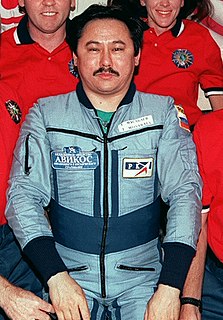
Talgat Amangeldyuly Musabayev is a Kazakh test pilot and former cosmonaut who flew on three spaceflights. His first two spaceflights were long-duration stays aboard the Russian space station Mir. His third spaceflight was a short duration visiting mission to the International Space Station, which also carried the first paying space tourist Dennis Tito. He retired as a cosmonaut in November 2003. Since 2007 he has been head of Kazakhstan's National Space Agency, KazCosmos.

Aleksandr Yuriyevich "Sasha" Kaleri is a Russian cosmonaut and veteran of extended stays on the Mir Space Station and the International Space Station (ISS). Kaleri has most recently been in space aboard the ISS serving as a flight engineer for the long duration Expedition 25/26 missions. He has spent the fourth-longest time in space of any person, the longest time in space of any currently active cosmonaut, and the longest time in space of any person not born in what is now Russia.
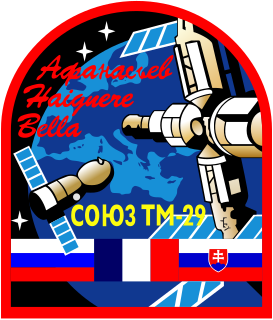
Soyuz TM-29 was a Russian manned spacecraft launched from the Baikonur Cosmodrome aboard a Soyuz 11A511U rocket. It docked with Mir on February 22 at 05:36 GMT with Cosmonauts Viktor Afanasyev of Russia, Jean-Pierre Haigneré of France, and Ivan Bella of Slovakia aboard. Since two crew seats had been sold, Afanasyev was the only Russian cosmonaut aboard. This meant that Russian engineer Avdeyev already aboard Mir would have to accept a double-length assignment. After the February 27 departure of EO-26 crew commander Padalka and cosmonaut Bella aboard Soyuz TM-28, the new EO-27 Mir crew consisted of Afanasyev as Commander, Avdeyev as Engineer and French cosmonaut Haigneré.

Sergei Vasilyevich Avdeyev is a Russian engineer and cosmonaut.

Vasily Vasiliyevich Tsibliyev ; born on February 20, 1954) is a Russian cosmonaut.
Aleksandr Stepanovich Viktorenko is a Soviet cosmonaut. He was born in Olginka, North-Kazakhstan Oblast, Kazakh SSR on March 29, 1947. He is married with two children.

Valeri Vladimirovich Polyakov is a former Russian cosmonaut. He is the holder of the record for the longest single stay in space in human history, staying aboard the Mir space station for more than 14 months during one trip. His combined space experience is more than 22 months.
Aleksandr Ivanovich Laveykin is a retired Soviet cosmonaut.

Spaceflight began in the 20th century following theoretical and practical breakthroughs by Konstantin Tsiolkovsky and Robert H. Goddard. The Soviet Union took the lead in the post-war Space Race, launching the first satellite, the first man and the first woman into orbit. The United States caught up with, and then passed, their Soviet rivals during the mid-1960s, landing the first man on the Moon in 1969. In the same period, France, the United Kingdom, Japan and China were concurrently developing more limited launch capabilities.
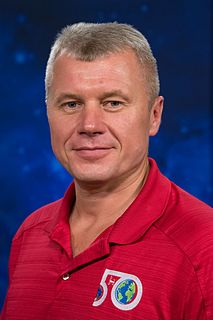
Oleg Viktorovich Novitskiy, lieutenant colonel in the Russian Air Force, is a Russian cosmonaut.

Aleksey Nikolayevich Ovchinin born 28 September 1971 in Rybinsk, Yaroslavl Oblast, Russian SFSR is a Russian Air Force Major and cosmonaut, who was selected in 2006. Ovchinin made his first spaceflight in 2016, and was assigned as Commander of Soyuz MS-10 in 2018.

Sergey Aleksandrovich Volkov is a retired Russian cosmonaut and engineer. He was a member of three missions to the International Space Station, spending more than a year in total in space. During his missions he did four spacewalks lasting more than 23 hours in total.
Volkov retired from the Cosmonaut group in February 2017.

Soyuz TMA-18M was a 2015 Soyuz spaceflight to the International Space Station. It provided the two twelve-months occupants at the International Space Station with a fresh Soyuz capsule. TMA-18M was the 127th flight of a Soyuz spacecraft; the first having occurred in 1967. The ascent flight consisted of a Russian commander and two flight engineers from Denmark (ESA) and Kazakhstan respectively. The flight launched in September 2015 and returned to Earth in March 2016.




